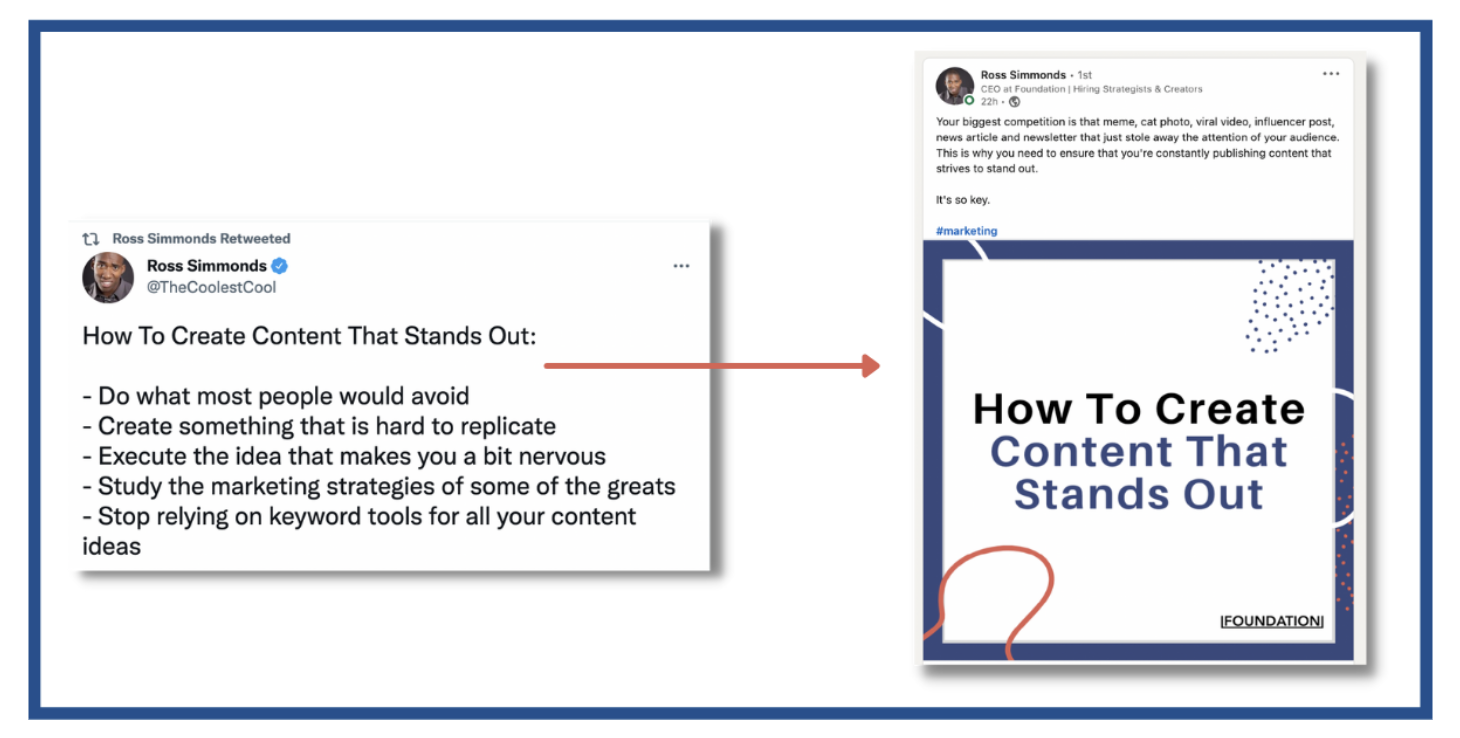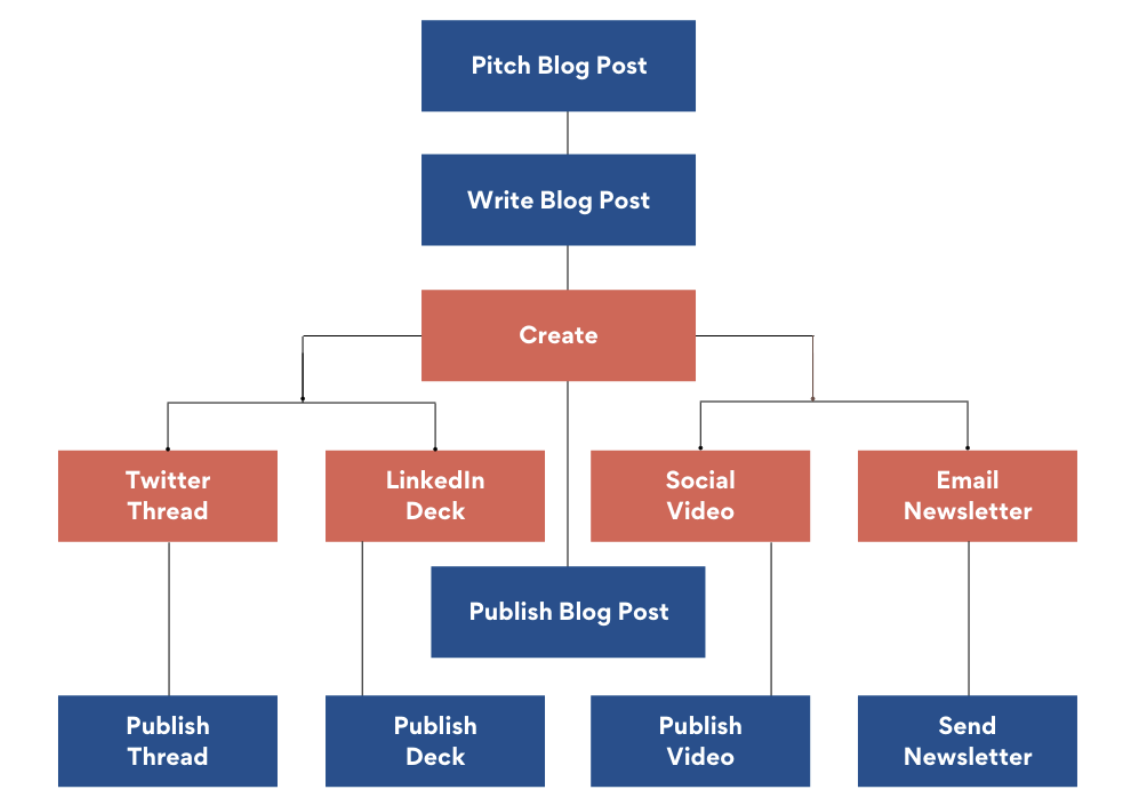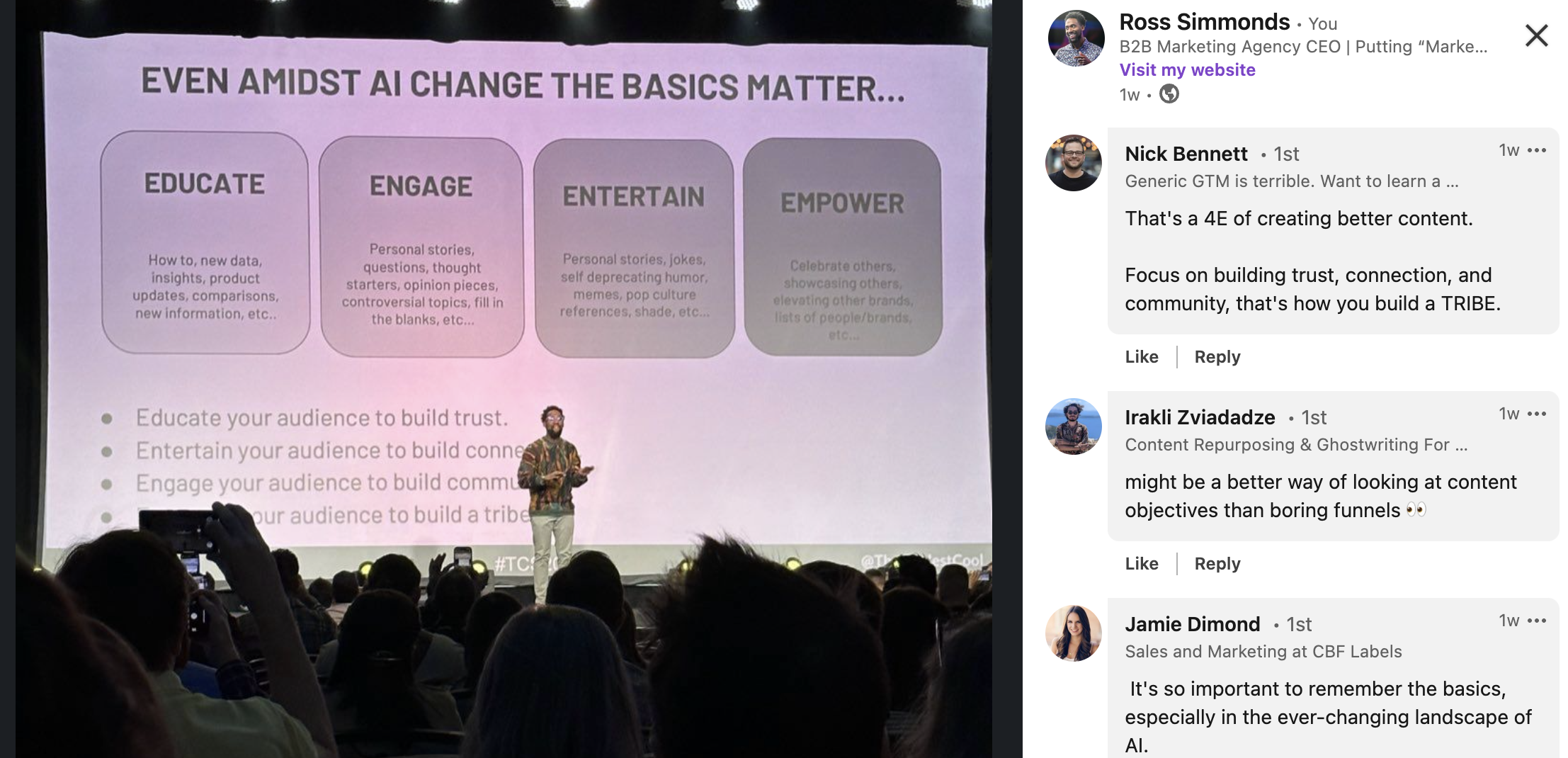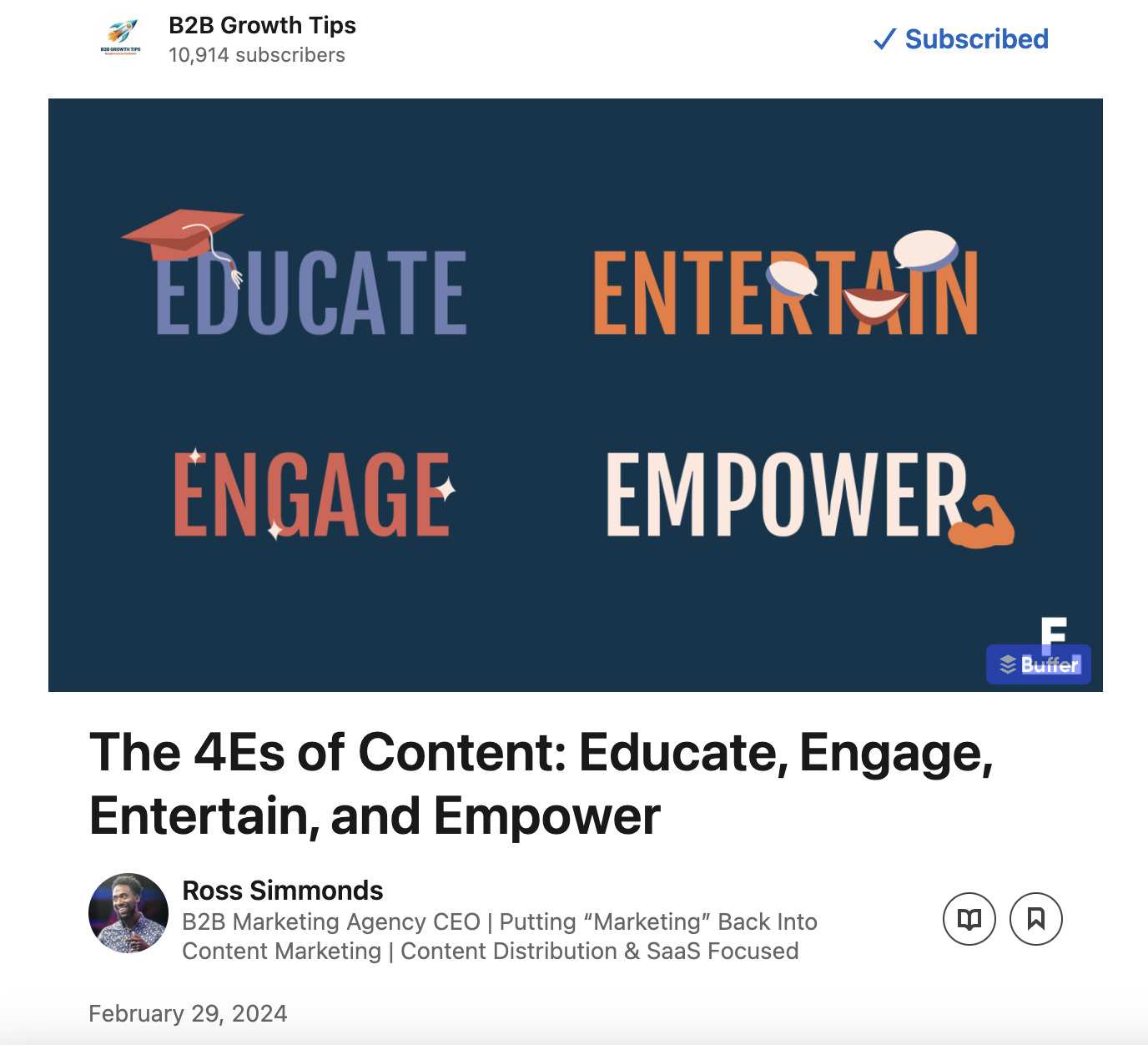You’ve built a dream team of content creators.
Your keyword research is meticulous.
Your content strategy seems bulletproof.
But here’s the kicker: is your repurposing and content distribution strategy ACTUALLY optimized for success?
Over the last 10 years, I’ve helped brands generate 10x more page views on the back of content repurposing strategies. I’ve collaborated with brands like Wix to discuss content distribution, I created a course on content distribution with LinkedIn and wrote an Amazon Best Seller dedicated to the topic of content distribution.
Why?
Because so many brands have existing content in a backlog—which should be the cornerstone of their brand’s narrative.
By tapping into your treasure trove of pre-developed content, you’re not only stretching your team’s capabilities but also maximizing the ROI out of everything you create, unlocking the hidden potential of every single piece you’ve crafted.
So why settle for less when you can squeeze every ounce of value from your content, turning your time and resources into a turbocharged engine for success?
It’s time to seize the opportunity and harness the power of content repurposing to elevate your brand to new heights.
Let’s start at the top:
What Is Content Repurposing?
Repurposing content, known as “content recycling,” is a strategic approach that involves reusing existing content to expand its reach and impact.
By repackaging content into various formats, such as transforming a blog post into an informative infographic, businesses can effectively engage with diverse audiences and maximize the value of their original content assets. This practice not only extends the lifespan of content but also enhances its relevance and accessibility across different platforms and channels.
Content repurposing is the strategic practice of taking existing content assets and transforming them into different formats or repackaging them for distribution across various channels. Rather than creating entirely new content from scratch, content repurposing involves extracting value from previously produced material by adapting it to suit different platforms, target audiences, or communication objectives. This approach allows businesses to maximize the utility and longevity of their content investments, expand their reach across diverse audience segments, improve search engine visibility, and maintain brand consistency.
Content repurposing entails breathing new life into existing content to extend its relevance, amplify its impact, and achieve greater marketing effectiveness.
What Content Can You Repurpose?
Content repurposing can be done across almost any medium.
The most versatile format for content is written word. It’s how I started my content repurposing journey back in 2015 when I started turning blog posts into 5-6 other content formats:
I took a blog post and turned a section of it into a LinkedIn article and then turned that into a YouTube video.
Since then…
These assets have combined to reach thousands of marketers and help them understand how Reddit can be used for marketing.
The starting point for figuring out what to repurose is asking:
What have I created worth sharing?
When considering what content to repurpose, keep in mind that any type of existing content can be a candidate for transformation.
This includes blog posts, articles, whitepapers, case studies, infographics, videos, podcasts, webinars, social media posts, and more.
Tweets can become blog posts
Blog posts can become videos
Videos can become clips
Clips can become reels
And the cycle continues…
Each of these content formats offers unique opportunities for repurposing. For example, a well-received blog post can be repurposed into a series of social media posts, an infographic summarizing key points, or even a podcast episode discussing the topic in further detail. Similarly, a successful webinar can be repackaged into blog posts highlighting key takeaways, short video clips for social media, or downloadable resources for lead generation.
The key is to identify high-performing content that resonates with your audience and explore creative ways to adapt it into different formats or distribute it across various channels to maximize its reach and impact. Here’s an example of content repurposing happening with social media content:
The tweet started as a 5 step idea and turned into a LinkedIn carousel.
Content Repurposing Strategy: Developing A Repurposing Menu
Thinking about your content repurposing opportunities as a menu is a great way to maximize production without feeling constantly overwhelmed.
When you go to a restaurant, you don’t eat everything on the menu. You pick and choose a few dishes that will help you reach your goal of….not being hungry. At its core, the content repurposing menu can be thought of in a very similar way. Instead of repurposing every piece of content that you want to publish into:
- A Twitter thread
- A LinkedIn deck
- 5+ LinkedIn shares
- 5+ Twitter shares
- 2 + Instagram posts
- A YouTube video
- A Medium post
- 2-3 eBooks
- A PDF downloadable
- A webinar summary
- And more
You can pick and choose a few that help you reach your goals, without stretching your team too thin.
For example, when we publish a teardown there are around 30+ different ways we can repurpose that into new content.
That includes things like a Twitter thread, a LinkedIn deck, miscellaneous visual content, a downloadable PDF, an ebook, and more. We know that each of these repurposed assets is valuable to our followers, and will help the original content be seen by more people.
We often lack the time and resources to create all assets for every teardown, blog post, or webinar. The content repurposing menu allows us to select key items to amplify the reach of the original content to the appropriate audience. Each repurposed asset comes with a designated creation time, aiding project managers in assigning tasks for maximizing these opportunities.
Another fantastic aspect of the content repurposing menu is its ability to assist in mapping out your content strategy weeks or even months ahead. By utilizing this tool, you can create a content calendar and meticulously plan for each content piece you wish to release, ensuring you have a variety of repurposed assets to supplement it. This proactive approach safeguards against neglect when task lists pile up during busy periods. At Foundation, our strategic blueprint includes: 2 or more Twitter threads, over 15 social media posts, an engaging email newsletter, a downloadable eBook, visually appealing graphics, and a myriad of other innovative elements to enhance our content offerings.
How To Identify Content Worth Repurposing
The best process for repurposing content is to know that you’re going to repurposing content from the start.
A lot of organizations and content teams think about content repurposing as an afterthought. The best teams recognize that as soon as a piece goes live, it’s important that the organization and writers to begin crafting assets that can supplement and support the original asset being distributed and amplified. This is what at Foundation we call proactive repurposing.
Here’s a snapshot of the process and what it looks like in action:
Looking to elevate your content strategy without reinventing the wheel? Enter content repurposing – the ultimate strategy to maximize your existing assets.
But how do you determine which content warrants repurposing?
Here’s your definitive guide to unleashing the full potential of your content arsenal:
Analyze Performance Metrics:
Studying your own metrics to determine what content to repurpose is an essential step in the content repurposing process. It’s akin to mining your existing resources for gold. By examining the performance metrics of your content, you gain invaluable insights into what resonates with your audience, what drives engagement, and what fosters conversions. Performance metrics such as page views, time spent on page, social shares, and conversion rates serve as a compass guiding your repurposing efforts.
This data-driven approach ensures that you’re not just shooting in the dark but rather making strategic decisions that amplify the reach and impact of your most compelling content. In essence, analyzing performance metrics empowers you to identify evergreen gems within your content repository—those pieces that have proven their worth and can be polished and presented anew for continued success.
- Dive into your analytics to identify top-performing content. Look for pieces that have generated high engagement, traffic, or conversions.
- Pay attention to metrics such as page views, time on page, social shares, and comments to gauge audience interest and resonance.
Consider Evergreen Topics:
Evergreen topics are the cornerstone of a sustainable content strategy.
Especially when it comes to content repurposing.
One of the best examples I have on content repurposing is the way I have repackaged the idea behind the 4 Es.
It’s a concept I’ve shared on stage (and people took photos of) which led me to sharing it on LinkedIn:
The concept of the 4Es which is meant to give marketers guidelines around the types of stories they should tell online is evergreen in nature.
So when I share it as an idea in my newsletter on LinkedIn:
But it doesn’t end with social media channels.
Our team at Foundation, took the idea and turned it into a blog post:
The 4Es of Content: Educate, Engage, Entertain, and Empower
Which wasn’t just a bunch of text…
It also came with this interesting infographic:
That’s how you make the most out of content repurposing an Evergreen Asset.
Oh.
And did I mention..
Here we are again using it to educate you on the topic of Content Repurposing?
Meta right?
Evergreen content assets remain relevant and valuable to your audience over time, transcending seasonal trends or temporary market interests.
By focusing on repurposing your evergreen topics, you can create a repository of content that serves as a reliable resource for both new and returning visitors.
Repurposing this type of content can significantly extend its lifespan and enhance your brand’s authority in your niche. For instance, updating an evergreen article with fresh data, insights, or emerging trends not only revitalizes the piece but also improves its SEO performance, potentially attracting a new wave of readership.
But on the topic of repurposing – evergreen content can be seamlessly adapted across different formats—turning a popular blog post into an infographic, video, podcast episode, or even a series of social media posts—each iteration reaching different segments of your audience and maximizing engagement. By strategically leveraging evergreen topics, marketers ensure their content efforts yield long-term dividends, reinforcing their brand’s presence and relevance in the digital landscape.
- Focus on content that covers evergreen topics or timeless themes. These pieces have a longer shelf life and can be repurposed multiple times without becoming outdated.
- Look for content that addresses fundamental questions or provides valuable insights that remain relevant to your audience over time.
Listen to Audience Feedback:
Listening to audience feedback is crucial for identifying which content pieces are worth repurposing. Engagement metrics, such as comments, shares, and likes, serve as direct indicators of what resonates with your audience. Additionally, paying attention to the questions and discussions that emerge around your content can provide valuable insights into the needs and interests of your audience. By analyzing this feedback, you can discern which topics hold lasting appeal and warrant further exploration through different formats.
Leveraging direct communication channels like surveys or social media polls can help in gathering explicit input on what your audience wants more of. This approach ensures that your efforts in repurposing content are not only strategic but also aligned with the evolving preferences of your target demographic, thereby enhancing the impact and reach of your marketing campaigns.
- Pay attention to audience feedback, comments, and inquiries related to your content. Identify topics or themes that resonate most with your audience and explore ways to repurpose them to meet their needs.
- Engage with your audience through surveys, polls, or social media interactions to gather insights into their preferences and interests.
What Are The Benefits Of Content Repurposing?
Amidst the constant pressure to produce fresh, engaging content, marketers and creators often overlook a gold mine of value lying in their existing content.
That’s why content repurposing—a strategy that breathes new life into your content, extending its reach and value far beyond its original incarnation is so important.
Here’s something to keep in mind.
Marketers are busy.
Content teams are busy.
Content repurposing will give them the ability to maximize both ROI and their time by utilizing the assets you’ve already invested in.
Here’s how content repurposing not only maximizes your content’s ROI but also enhances your brand’s visibility, consistency, and engagement across various platforms.
Maximizing ROI
Creating high-quality content demands significant investment in terms of time, effort, and resources.
Content repurposing allows you to squeeze every drop of value out of these investments. Instead of relegating successful blog posts or reports to the annals of your content archive, give them a new lease on life. Transform a well-received blog post into an informative infographic or an engaging podcast episode, reducing production costs while expanding your content’s lifecycle.
Expanded Reach
Different people prefer different content formats. Some enjoy the depth and detail of a blog post, while others might prefer the quick visual overview an infographic provides, or the convenience of listening to a podcast while commuting. Repurposing content across various formats ensures that you engage with all segments of your audience, wherever they are.
Improved SEO
Search engines love fresh, relevant content. By updating older content, converting articles into new formats, and targeting fresh keywords, you can enhance your SEO efforts. Each piece of repurposed content is a new opportunity to rank in search results, driving more organic traffic to your site.
Enhanced Brand Consistency
Each time you repurpose content, you reinforce your brand’s message and values. Consistent content across multiple channels strengthens your brand identity, making it more recognizable and memorable for your audience. This consistency helps in building trust and authority in your niche.
Time Efficiency
In the relentless content treadmill, it’s easy to burn out. Repurposing content provides a breather, allowing you to maintain a steady stream of content without the constant need for new ideas. It’s a smarter, more sustainable approach to content creation that lets you focus on quality over quantity.
Opportunity for Experimentation
Repurposing content is an excellent way to test what formats and styles resonate most with your audience. You might find that a topic that didn’t perform well as a blog post gains traction as a video or an infographic. This experimentation can yield valuable insights, guiding your content strategy for better engagement and conversion rates.
Content Longevity
Quality content doesn’t have an expiration date. Repurposing enables you to keep your best work in the limelight, ensuring that new members of your audience don’t miss out on the value it offers. This practice not only extends the lifespan of your content but also ensures it continues to attract and engage users over time.
Lead Generation
Transforming your content into different formats can help you capture leads at various stages of the sales funnel. A comprehensive report can become an exclusive downloadable resource for subscribers, or snippets of an informative video series could form the basis of a compelling email nurturing campaign.
Conclusion
Content repurposing is not just about recycling old content; it’s about reimagining and revitalizing your message to ensure it achieves its maximum potential impact. By strategically repurposing content, you can enhance your brand’s reach, engagement, and conversion efforts, all while optimizing resource use and maintaining a strong, consistent brand presence across channels. It’s time to unlock the full potential of your content by turning single-use assets into multi-platform powerhouses that drive your brand forward.






